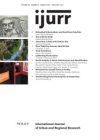This article traces the movement of the concept of ‘defensible space’ from New York City in the 1970s, where it was developed by the Canadian architect/planner Oscar Newman, to London in the 1980s and into design interventions in British public housing in the 1990s, through British geographer Alice Coleman, who acted as an especially powerful transfer agent. In focusing on this urban design ‘concept’ on the move we contribute to existing scholarship on policy mobility and city building in a number of ways. First, we explore an instance of the movement/mobility of a planning concept in a historical period (the recent past) largely overlooked to date. Secondly, we demonstrate that this movement was the result of a disaggregated series of expert knowledge transfers and localized translations of pre‐policy expert knowledge, generated through university‐based research work and networks. We theorize this instance of urban planning mobility by way of the interlinked insights offered by the sociology of science and policy‐mobilities literatures. As this is an instance of university research shaping public policy it also offers an opportunity to reflect upon the meaning of ‘evidence‐based policy’ and the impact agenda in contemporary higher education.
Details
Written by:
Jane M. Jacobs, Loretta Lees
Digital Object Identifier (DOI)
10.1111/1468-2427.12047
About DOI
Read full article as PDF
Read full article as HTML
See the references for this article
